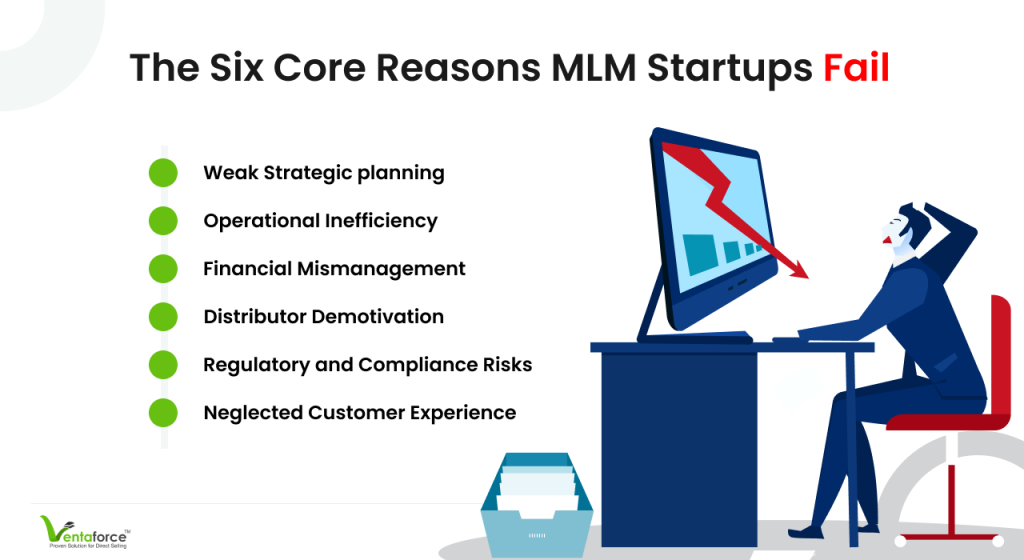Why Most MLM Startups Fail in Year One — And How to Avoid Common Pitfalls

The multi-level marketing (MLM) industry has long drawn ambitious entrepreneurs with promises of residual income, scalable networks, and global reach. Yet, despite its appeal, the reality is sobering: most MLM startups fail in their first year. Research indicates that nearly 8 out of 10 new MLM ventures collapse within 12 months. Enthusiasm alone is not enough to sustain a business model that relies heavily on structure, compliance, and long-term strategy.
This comprehensive guide examines why MLM startups fail, offers research-backed insights, and outlines practical strategies that can help new ventures survive and thrive. Subtle references to technology solutions, such as MLM software, are included as illustrative examples to highlight operational best practices.
The Reality of MLM Startup Failure
Global Statistics
MLM operates worldwide, but startup survival rates vary by region. According to the Direct Selling Association (DSA):
- North America : Around 70% of MLM startups fail within the first year.
- Asia-Pacific : Rapid expansion is common, yet nearly 75% of new ventures fail to sustain operations beyond 12 months.
- Europe : Tighter regulatory frameworks correlate with slightly higher survival rates (~65%).
Did you know ?
Over 55% of distributors quit within their first year if adequate tools, training, and incentives are not provided. (DSA, 2024)
Regional Differences
Cultural attitudes toward MLM, digital adoption, and regulatory enforcement all influence startup success. For instance :
- Countries with strict anti-pyramid scheme regulations (e.g., US, UK) report higher failure due to compliance violations.
- High smartphone penetration correlates with higher distributor retention when digital tools are used to manage operations.
The Six Core Reasons MLM Startups Fail

1. Weak Strategic Planning
Many startups fail because of inadequate planning :
- Unrealistic Goals : Startups may overestimate the number of distributors or revenue potential.
- Complex compensation plans : Without modeling and scenario testing, multi-tiered plans often become unsustainable.
- Neglecting market analysis : Competitor benchmarking and trend analysis are often ignored.
Mini Case Study
A skincare MLM projected 10,000 distributors in six months but only reached 2,000. Misalignment between expectations and market demand caused severe cash flow problems.
Did you know ?
Startups with comprehensive strategic plans are 2.5x more likely to survive their first year. (Harvard Business Review, 2023)
2. Operational Inefficiency
Operational challenges are a significant factor :
- Manual Processes : Commission calculations and distributor management using spreadsheets are prone to errors.
- Inventory mismanagement : Poor tracking can lead to stockouts or overstocking.
- Fragmented communication : Distributors often lack timely updates, affecting morale and sales performance.
Inefficient operations erode trust and limit the ability to scale.
3. Financial Mismanagement
Cash flow problems are a major cause of early failure :
- Overpayment of commissions : Promising bonuses without revenue backing can cripple finances.
- Budget oversight : Neglecting marketing, training, or operational expenses leads to imbalance.
- Revenue Misforecasting : Overestimating sales results in inventory and liquidity issues.
Did you know ?
Approximately 60% of MLM startups cite financial mismanagement as the leading cause of failure. (PwC Global Compliance Survey, 2024)
4. Regulatory and Compliance Risks
MLM businesses face complex legal scrutiny :
- Misrepresentation of products : Inaccurate claims can trigger legal consequences.
- Recruitment-based incentives : When commissions depend excessively on recruitment rather than product sales, legal risks increase.
- Financial reporting Gaps : Incomplete records can lead to audits and penalties.
Non-compliance can result in fines, lawsuits, or complete shutdowns — particularly damaging for small startups.
5. Distributor Demotivation
Distributors are the lifeblood of MLM :
- Lack of training : Distributors cannot perform well without clear guidance.
- Delayed or disputed commissions : Errors in payouts reduce engagement.
- Poor recognition systems : Achievements that are not acknowledged lead to attrition.
Case Example
A wellness MLM lost 35% of distributors in the first six months due to commission errors. Implementing automated commission tracking improved retention by 40%.
6. Neglected Customer Experience
Customer retention is often overlooked :
- Poor service, slow delivery, and lack of personalized engagement reduce repeat purchases.
- Negative online reviews impact recruitment and brand credibility.
Did you know ?
Startups that focus on customer retention strategies see an average 50% increase in repeat purchases compared to recruitment-only approaches.
Did You Know? Insights
- Attrition rates : 70% of distributors quit within 12 months if unsupported.
- Compliance penalties : MLM-related regulatory fines rose 30% in the past decade.
- Analytics advantage : Companies using real-time data grow 23% faster.
- Gamification: Engaging distributor dashboards improve participation by 30%.
- Global expansion : 40% of successful startups expand internationally within three years.
How MLM Software Technology Mitigates Risks
While human factors are critical, technology offers operational stability :
Function | Benefit |
Commission automation | Reduces disputes, increases transparency |
Centralized management | Streamlines onboarding, training, and communication |
Compliance monitoring | Safeguards against legal risks |
Analytics dashboards | Provides actionable insights for decision-making |
Motivational tools | Leaderboards, badges, mobile access improve engagement |
Scalability features | Supports multi-language, multi-currency, and global growth |
Example Mention :
Platforms like Ventaforce mlm software demonstrate how structured technology can reduce operational risk and improve distributor retention (illustrative only).
Practical Recommendations to start successful Direct Selling Business
- Comprehensive Business Plan : Research, realistic projections, contingency modeling.
- Early Adoption of Automation : Reduce errors, increase trust.
- Compliance Vigilance : Incorporate legal safeguards from the start.
- Distributor Training & Support: Continuous learning and accessible tools.
- Customer Retention Focus : Quality, service, personalization.
- Data-Driven Insights : Track performance metrics and adjust strategies proactively.
- Scalability Planning : Ensure systems can support global growth.
Conclusion
Surviving the first year of an MLM startup is challenging but not impossible. Failures are often caused by predictable issues: weak planning, operational inefficiency, financial mismanagement, compliance failures, distributor attrition, and poor customer retention.
Structured processes, data-driven strategies, and supportive technology — including automation and analytics tools — provide the foundation for sustainable growth. By addressing these challenges, MLM startups can not only survive their first year but establish a framework for long-term success.
Why Is Direct Selling Profit Is More Than Any Other Business?
Frequently Asked Questions
Key causes: poor planning, financial mismanagement, compliance issues, distributor attrition, poor customer experience.
It automates operations, improves transparency, ensures compliance, and provides analytics for better decision-making.
Multi-compensation plan support, analytics dashboards, mobile access, compliance modules, e-commerce integration, and scalability.
Yes. Automation reduces errors and provides a foundation for scalable growth.
No, software supports operations but does not replace strategy, leadership, or engagement.
Yes. Compliance requirements vary by country, including recruitment-based commission rules and tax reporting.
Training, gamified tracking, recognition, and timely payouts enhance engagement.
Timely delivery, personalized service, high-quality products, and loyalty programs.








